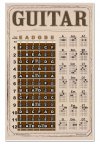John-G
The Long and Winding Road
One of the biggest and frustrating challenges for all guitarists is learning and memorizing notes on the fretboard. It has been for me for the past few years. I'm aware of the various methods - 6th string up and down, 5th string up and down, shapes (triangles), chess moves (2 across, three down). Been there, tried that, but to no avail. A few days ago I received a post in FB with a fretboard diagram - one of millions - but this one, for some reason, caught my eye, and after really looking at it, it suddenly clicked, the light went on above my head and a wonderful realisation engulfed me. I found a way to memorize the notes on the fretboard !! I tested myself a few hrs after, and still got it right. I find myself mentally visualizing the fretboard, saying the notes , and it all falls in place. Now I have to put my newfound skill into practice and hopefully I'm one step closer to being a better and more accomplished player. Cheers 



